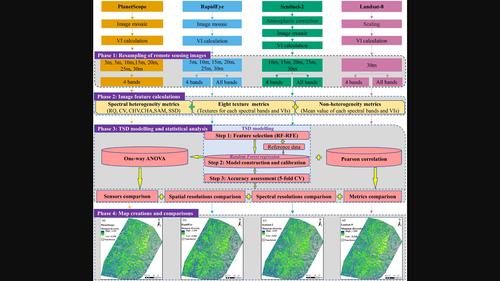从空间光学图像绘制树种多样性图:光谱和空间分辨率的影响
IF 4.3
2区 环境科学与生态学
Q1 ECOLOGY
引用次数: 0
摘要
越来越多的空间传感器为大规模、及时和连续的树种多样性(TSD)监测提供了前所未有的机会。然而,由于光谱和空间分辨率的差异,传感器的选择并不总是那么简单。在这项工作中,我们研究了四种星载传感器(RapidEye、Landsat-8、Sentinel-2 和 PlanetScope)的空间和光谱分辨率对德国黑森林约 4000 平方公里区域内 TSD 地图绘制的影响。我们采用随机森林(RF)回归模型来预测香农-维纳多样性,该模型基于七种光谱异质性指标(纹理、变异系数、Rao's Q、凸壳体积、光谱角度映射器、凸壳面积和光谱物种多样性)和 135 个一公顷样地的完整调查数据集。我们比较了射频模型在不同传感器和空间分辨率下的性能。结果表明,基于哨兵-2 的 TSD 模型精度最高(平均 R2:0.477, 平均均方根误差 (RMSE): 0.274)。基于 RapidEye 的 TSD 模型精度较低(平均 R2:0.346,平均均方根误差:0.303),但优于基于 PlanetScope 和 Landsat 的 TSD 模型。10 米(哨兵-2 和 RapidEye)和 15 米(PlanetScope)是预测 TSD 的最佳空间分辨率。近红外波段是预测 TSD 最有利的光谱波段。纹理度量和拉奥 Q 值优于其他光谱异质性度量。我们的研究结果表明,空间光学图像(尤其是哨兵-2)可成功用于大规模 TSD 测绘,但传感器的选择会严重影响温带山地森林的测绘精度。本文章由计算机程序翻译,如有差异,请以英文原文为准。

Tree species diversity mapping from spaceborne optical images: The effects of spectral and spatial resolution
Increasingly available spaceborne sensors provide unprecedented opportunities for large-scale, timely and continuous tree species diversity (TSD) monitoring. However, given differences in spectral and spatial resolutions, the choice of sensor is not always straightforward. In this work, we investigated the effects of spatial and spectral resolutions for four spaceborne sensors (RapidEye, Landsat-8, Sentinel-2 and PlanetScope) on TSD mapping in an area of approximately 4000 km2 within the Black Forest, Germany. We employed a random forest (RF) regression model to predict Shannon–Wiener diversity based on seven types of spectral heterogeneity metrics (texture, coefficient of variation, Rao's Q, convex hull volume, spectral angle mapper, convex hull area and spectral species diversity) and a full survey dataset from 135 one-ha sample plots. We compared the RF model's performance across sensors and spatial resolutions. Our results demonstrated that the Sentinel-2-based TSD model achieved the highest accuracy (mean R2: 0.477, mean root-mean-square error (RMSE): 0.274). The RapidEye-based TSD model produced lower accuracy (mean R2: 0.346, mean RMSE: 0.303), but it was better than the PlanetScope- and Landsat-based TSD models. The 10 m (for Sentinel-2 and RapidEye) and 15 m (for PlanetScope) were the best spatial resolutions for predicting TSD. The NIR band was the most favourable spectral band for predicting TSD. Texture metrics and Rao's Q outperformed the other spectral heterogeneity metrics. Our results highlighted that spaceborne optical imagery (especially Sentinel-2) can be successfully used for large-scale TSD mapping but that the choice of sensors can significantly affect the resulting mapping accuracy in temperate montane forests.
求助全文
通过发布文献求助,成功后即可免费获取论文全文。
去求助
来源期刊

Remote Sensing in Ecology and Conservation
Earth and Planetary Sciences-Computers in Earth Sciences
CiteScore
9.80
自引率
5.50%
发文量
69
审稿时长
18 weeks
期刊介绍:
emote Sensing in Ecology and Conservation provides a forum for rapid, peer-reviewed publication of novel, multidisciplinary research at the interface between remote sensing science and ecology and conservation. The journal prioritizes findings that advance the scientific basis of ecology and conservation, promoting the development of remote-sensing based methods relevant to the management of land use and biological systems at all levels, from populations and species to ecosystems and biomes. The journal defines remote sensing in its broadest sense, including data acquisition by hand-held and fixed ground-based sensors, such as camera traps and acoustic recorders, and sensors on airplanes and satellites. The intended journal’s audience includes ecologists, conservation scientists, policy makers, managers of terrestrial and aquatic systems, remote sensing scientists, and students.
Remote Sensing in Ecology and Conservation is a fully open access journal from Wiley and the Zoological Society of London. Remote sensing has enormous potential as to provide information on the state of, and pressures on, biological diversity and ecosystem services, at multiple spatial and temporal scales. This new publication provides a forum for multidisciplinary research in remote sensing science, ecological research and conservation science.
 求助内容:
求助内容: 应助结果提醒方式:
应助结果提醒方式:


